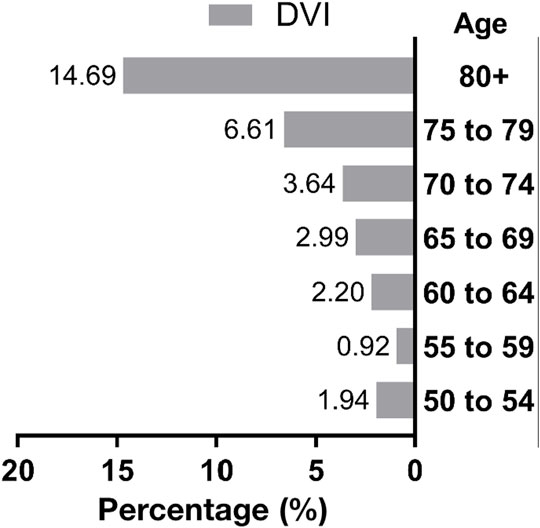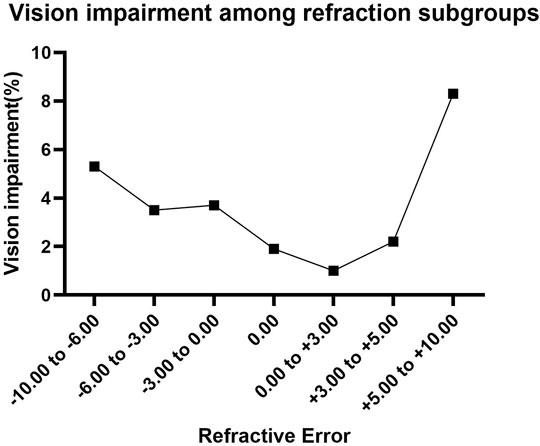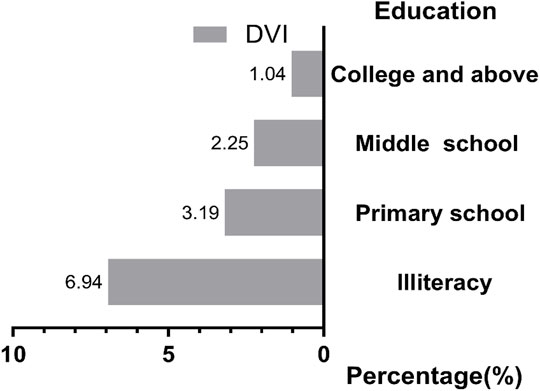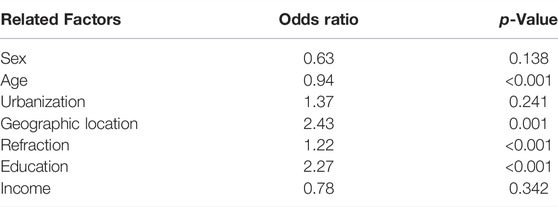- 1Eye Institute and Affiliated Xiamen Eye Center of Xiamen University, School of Medicine, Xiamen University, Xiamen, China
- 2Fujian Provincial Key Laboratory of Corneal & Ocular Surface Diseases, Xiamen, China
- 3Department of Epidemiology and Biostatistics, School of Public Health, Peking University Health Science Centre, Beijing, China
- 4Department of Ophthalmology, Peking University People’s Hospital, Beijing, China
Purpose: To evaluate the prevalence and correlations of vision impairment (VI) among urban and rural adults in a coastal province of Southern China.
Design: Population-based cross-sectional study.
Methods: The study was designed to recruit residents aged over 50 years in randomly sampled communities of Fujian Province from 2018 to 2019. Participants completed a questionnaire about socioeconomic and biological factors and underwent visual examinations. Best corrected visual acuity (BCVA) was measured for the participants to assess VI, which was defined as best corrected visual acuity (BCVA) in better eyes of 20/60 or worse.
Results: A total of 6,823 participants were included in this report. VI prevalence was higher in inland populations, compared with that in coastal populations (5.08 vs. 2.79%, p < 0.001), but there was no significant difference between urban populations and rural populations (2.97 vs. 3.73%, p = 0.082). VI was significantly associated with sociodemographic and biological factors, which included age, educational background, income, and refractive error. Sex and urbanization were not statistically significantly associated with VI.
Conclusion: High prevalence of VI in southeast China suggested need for more accessible services and favorable policies for enhancing eye health in rural and inland elderly people.
Introduction
Vision impairment (VI) affects approximately 2.2 billion people globally, and the majority of them are over the age of 50 years (World Health Organization Geneva, 2019). Thus, the improvement of visual function has always been a major world health issue. The World Health Organization (WHO) adopted the Universal Eye Health: A Global Action Plan 2014–2019 at the World Health Assembly in 2013 (World Health Organization, 2013), and one of the key objectives is to generate evidence on the magnitude of VI, which affects quality of life, educational and economic opportunities, and risk of death (Bourne et al., 2017).
According to the International Classification of Diseases version 11, VI which includes presbyopia was classified as mild VI, moderate VI, and severe VI, and only the definition of distance visual acuity standard was given (World Health Organization, 2019). It is obvious that VI has been reported worldwide. However, various issues remain unclear, including the prevalence and associations of general VI in the population. Most of the studies reported urbanization and geographic location separately. To address these gaps in knowledge, a population-based cross-sectional survey, the Fujian Eye Study (FJES), was conducted on residents aged 50 years and above in Fujian Province of southern China. It is the initial report about the prevalence and associations of VI in a whole province of southern China. Also, the study assessed both urbanization and geographic location factors under the same baseline. The aim of this study was to estimate the overall VI and its related factors among adults using a more comprehensive approach, so as to provide the latest data for planning and policy-making.
Methods
Study Design
The Fujian Eye Study (FJES) is a population-based, cross-sectional investigation on the residents’ state of eye health in Fujian Province, southeast China. The report of the World Health Organization (WHO) in 2019 showed VI affects approximately 2.2 billion people globally, and the majority of them are over the age of 50 years (World Health Organization Geneva, 2019). Most fundus diseases also occur in people over 50 years old, and most of them are retired at home, which makes them easy to recruit. With the aggravation of population aging in China, research on eye diseases in people over 50 years old is imperative. Therefore, this study investigated the prevalence and related factors of VI in community members aged 50 years and above. Random cluster sampling was used in this investigation, and the calculation formula and sample size have been reported (Li et al., 2022). The Ethics Committee of Xiamen Eye Center affiliated with Xiamen University approved the 2018–2019 FJES protocol (Acceptance Number: XMYKZX-KY-2018-001).
Recruitment Procedures
Participants underwent a comprehensive physical examination in a mobile clinic. Those who were unable to participate in on-site examination in the screening were asked for the consent of home visits and simple ophthalmic examinations. The main contents of this study include the following: questionnaire (age, sex, and race; educational background, income level, occupation, etc.); presenting visual acuity; best corrected visual acuity (BCVA); and refractive state. The flowchart of field screening has been reported (Li et al., 2022).
We used the E Standard Logarithmic Visual Acuity Chart (GB 11533–1989) for the visual acuity test at a distance of 5 m. The study defined VI as BCVA in better eyes worse than 0.3 [equaled with 20/60 in the WHO definition of VI (World Health Organization, 2019)] and blindness as BCVA in better eyes of 0.05 or worse [equaled with 20/400 in the WHO definition of VI (World Health Organization, 2019)].
Refractive errors [spherical (DS), cylinder (DC), axis (a)] were conducted three times by Topcon KR800 (Topcon, Japan) in both eyes, and the average was calculated as the final outcome.
Data Collation
Data were collated using double entry. Each resident has a unique identification code to accurately locate their data. We supplemented part of the missing data through telephone follow-up. If we cannot contact the resident, it is considered missing data.
Statistical Analysis
Data were analyzed using Stata/SE statistical software v15.1 (Stata for Windows, StataCorp LLC, Lakeway Drive, College Station, TX, United States). Data are displayed in the mean ± standard deviation (SD) form. Chi-square (x2) tests were used for comparing proportions. Linear regression was used for checking whether there was a correlation between VI and research factors. Logistic regression was used to determine the degree of correlation among each group. Multiple regression was applied for testing the correlation between VI (binary variable) and several parameters. The statistical correlation was described using the correlation coefficient r and the degree of correlation was shown as odds ratio (OR). A p-value of less than 0.05 was considered statistically significant for all the estimates.
Results
Vision Impairment
A total of 6,823 participants were included in this study (Li et al., 2022). The percentage and relationship of several VIs are presented in Figure 1. There was no significant difference in VI between the urban and rural groups, whereas VI was significantly reduced in the coastal group compared with the inland group (Figure 2).

FIGURE 1. Percentage and relationship of presenting near vision impairment (PNVI), distance vision impairment (DVI), and combined vision impairment (CVI) in the Fujian Eye Study and the distribution of several global reports mentioned in this article.
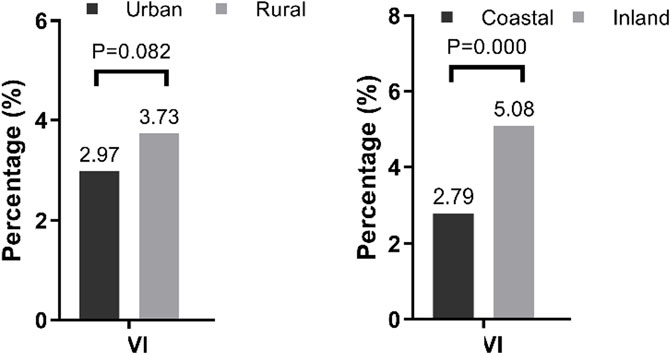
FIGURE 2. Percentage and comparison of distance vision impairment between urban and rural population groups and between coastal and inland population groups.
Correlation of VI With Region
On the whole, VI (r = 0.017, p = 0.082) was independent of urbanization. VI (r = 0.05, p < 0.001) showed a significant correlation with geographic location.
Correlation of VI With Age
In general, VI (r = 0.14) showed a significant (p < 0.001) correlation with age. Differentiating participants into the urban group and rural group or the coastal group and inland group yielded similar results (Figure 3).
Correlation of VI With Refractive Error
In all, VI (r = 0.18) was significantly (p < 0.001) correlated with refractive error. The whole population was grouped according to the degree of refractive error. The prevalence of VI increased significantly with diopter deviation. The prevalence of VI in the mild hyperopia group was low and also significantly increased with the deviation of diopter (Figure 4).
Correlation of VI With Education
Generally, VI showed a significant (p < 0.001) association with the degree of educational background (r = 0.20).
Given that the urban group and inland group had a significantly higher education level (p < 0.001) (Li et al., 2022), the whole population was grouped based on the education level and showed similar results. With the improvement of education level, the prevalence of VI gradually decreased (Figure 5).
Correlation of VI With Income
In general, VI showed a significant (p < 0.001) association with the degree of income (r = 0.13).
Given that the urban population group (p < 0.001) and inland population group (p < 0.001) had a significantly higher income, the whole population was grouped according to the income level. As the income level increased, the prevalence of VI also gradually decreased (Figure 6).
Correlation of VI With Sex
In univariate analysis, the prevalence of VI did not vary significantly (x2 = 0.04; p = 0.849) between males and females.
Multiple Regression
A multiple logistic regression analysis was performed because some of these parameters, such as refractive error and age, had a significant (p < 0.001) correlation with each other. The study factors such as age, sex, degree of urbanization (urban vs. rural), geographic location (coastal vs. inland), education, income, and refractive error were analyzed, and their association with VI is shown in Table 1. Age, refraction, education, and income were correlated with VI, while sex and urbanization were independent of VI.
Discussion
With an aging global population, the demand for eye health services is increasing. Hence, the exploration of related factors of VI in different areas was required. Although plenty of studies (Zou et al., 2002; He et al., 2006; Iwase et al., 2006; Xu et al., 2006; Yonekawa et al., 2011; Hong et al., 2013; Patil et al., 2014; Guo et al., 2017; Salomão et al., 2018; Tham et al., 2018; Wolfram et al., 2019; Bikbov et al., 2020) have shown the percentage of VI and its correlations based on various factors, including age, sex, physical health, and ethnic background, few studies have assessed the differences between coastal and inland populations. Accordingly, the present study aims to estimate the prevalence of VI and its sociodemographic and biological associations among the same population group both in urban and rural areas as well as inland and coastal regions, and the study design was more detailed and refined than ever before.
The prevalence of blindness and VI in this study was lower than the global prevalence in a Lancet review (Bourne et al., 2017). This may be due to China’s positive response to WHO Vision 2020’s emphasis on eye health and the formulation of the 13th Five-Year Plan for National Eye Health (2016–2020) (National Health Commission of the People’s Republic of China, 2016) and the “Bright in the Country” Project (China National Blindness Prevention and Treatment, 2020). Moreover, as a port of Southeast China, Fujian Province has relatively developed economy, so people could access better eye health services. Besides, the difference in lifestyle among coastal Chinese may also be an important factor. Because of its particularity, such as tea consumption and living habits, its influence on eye health will be discussed in our future articles. An Ireland study highlighted the inequality of access to appropriate transport for rural vision-impaired people (Gallagher et al., 2011), and the Brazilian Amazon Region Eye Survey reported that older adults living in remote regions with limited access to eye health services were at higher risk of developing VI and blindness (Salomão et al., 2018). While our study found no difference between urban and rural areas in VI prevalence. A possible explanation may be that the southeast coastal area of China is more developed than the northwest inland area on the whole, so the gap between urban and rural regions is small, and the proportion of medical insurance burden is close, so there is no significant difference in the prevalence of VI between urban and rural regions in this study population. Besides, the data of the WHO Study on Global Aging and Adult Health revealed that the intercountry heterogeneity of correlations observed among countries might also be present within countries (e.g., between Eastern China and Western China) (Bourne et al., 2019), which confirmed the difference between southeast China and other countries. VI in inland regions is worse than that of coastal regions, which is consistent with the Papua New Guinea nationwide survey that demonstrated that MVI (moderate vision impairment) was observed in coastal areas compared with NCD (National Capital District) and islands. For all areas, untreated cataract was the most common reason for blindness (88.6%), SVI (89.3%, severe VI), and MVI (76.1%). The second probable cause of blindness (3.9%) was other posterior segment eye diseases. The chief cause of EVI (45.3%, early VI) was uncorrected refractive error (Lee et al., 2019). The Coimbra Eye Study also demonstrated that the incidence of late AMD was reduced in a coastal town in central Portugal compared with major epidemiological studies of European-descent populations (Farinha et al., 2019). Thus, these results indicate that the high prevalence of eye diseases may be the main reason for the difference.
The present study revealed a large gap of VI existed between urban and rural areas or coastal and inland regions. Our study found that the population in urban areas with a higher education level and higher income has less refractive error, which is consistent with other studies (Zou et al., 2002; He et al., 2006; Iwase et al., 2006; Xu et al., 2006; Yonekawa et al., 2011; Hong et al., 2013; Patil et al., 2014; Guo et al., 2017; Salomão et al., 2018; Tham et al., 2018; Wolfram et al., 2019; Bikbov et al., 2020). Compared with the inland group, the coastal group has better vision function and less myopia on the whole. The potential differences in education level, economic level, transportation, environmental reasons, and lifestyle causes may be important factors in vision change development, such as the coastal seafood diet (Joachim et al., 2015; Ghasemi Fard et al., 2019), higher UV levels (Williams et al., 2017; Bose et al., 2019; Vergneau-Grosset and Péron, 2020) in coastal regions, the higher comprehensive degrees of sustainable education development in coastal regions and the Central-south China (Geng and Zhao, 2020), and the faster economic development in coastal areas (Small, 2004; Ren et al., 2019).
Many studies have reported that age and refractive error are associated with VI and blindness on the surface (Zou et al., 2002; He et al., 2006; Iwase et al., 2006; Xu et al., 2006; Yonekawa et al., 2011; Hong et al., 2013; Patil et al., 2014; Guo et al., 2017; Salomão et al., 2018; Tham et al., 2018; Wolfram et al., 2019; Bikbov et al., 2020). Findings from our age subgroup showed in detail that with increasing age, the prevalence of VI was slightly lower in the 50- to 59-year-old groups, increased gradually in the 60- to 74-year-old groups, and doubled after 65 years of age. The VI prevalence of people over 80 years old was greater than seven times that of the 50- to 54-year-old group. This trend was initially reported and would be helpful in understanding the objective laws of vision based on age.
The prevalence of VI of mild hyperopia was the lowest and gradually increased with the deviation of diopter. It was previously reported that refraction reflected the function of the eye and was associated with damage. This notion was consistent with most studies (Zou et al., 2002; He et al., 2006; Iwase et al., 2006; Xu et al., 2006; Yonekawa et al., 2011; Hong et al., 2013; Patil et al., 2014; Guo et al., 2017; Salomão et al., 2018; Tham et al., 2018; Wolfram et al., 2019; Bikbov et al., 2020). The study also found that the VI prevalence of the inland population was significantly increased compared with that of the coastal population.
Our results also showed that as the level of education and income increased, VI significantly decreased, demonstrating that the previous report was worthy of attention, which reported cash transfers to incentivize health-promoting behavior appear to access more healthy individuals with the disease cured (Strader et al., 2020).
Our study also had some limitations. Due to a lack of consideration of population mobility, the response rate of this study was slightly low, which might have biased our results. Therefore, all kinds of non-response possibilities should be fully considered in future research in order to ensure sufficient representativeness. Because of the large amount of data, this study only reported the correlation of several social demographic factors, and further analysis on the correlation of VI with eye diseases is in progress.
In conclusion, these findings showed VI was significantly related to age, refractive error, education, and income in Fujian Province of southern China. Therefore, our study provided the latest data and played a theoretical and practical supporting role in policy-making. Since the etiology of VI is complicated, our observation could be incomplete and more in-depth explorations are needed.
Data Availability Statement
The original contributions presented in the study are included in the article/Supplementary Material; further inquiries can be directed to the corresponding authors.
Ethics Statement
The studies involving human participants were reviewed and approved by the Ethics Committee of Xiamen Eye Center affiliated with Xiamen University. The patients/participants provided their written informed consent to participate in this study.
Author Contributions
YL and QH took part in all parts of the study, including the study design, data collection, data analysis, the preparation of related data, writing, and revision. XQ and TR helped revise the data analysis and article. BW assisted in plotting and article revision. YH and XL oversaw the research, data, and article. All authors contributed to the study design, analysis, and writing of the article.
Funding
This study was supported by the National Natural Science Foundation of China (NSFC, No. 81870672), the National Natural Science Foundation of China Youth Fund (NSFC, No. 81900881), the Natural Science Foundation of Youth Innovation Program of Fujian Province (No. 2019D007 and No. 2020D028), the Xiamen Science and Technology Planning Project (No. 3502Z20184023), and the Medical and Healthcare Guiding Program of Xiamen City (No. 3502Z20199074).
Conflict of Interest
The authors declare that the research was conducted in the absence of any commercial or financial relationships that could be construed as a potential conflict of interest.
Publisher’s Note
All claims expressed in this article are solely those of the authors and do not necessarily represent those of their affiliated organizations, or those of the publisher, the editors, and the reviewers. Any product that may be evaluated in this article, or claim that may be made by its manufacturer, is not guaranteed or endorsed by the publisher.
Acknowledgments
We thank all members of the FJES group (Liting Wang, Yi Liu, Wufu Qiu, Menging Lin, Yanhong Zhang, and Zhenglingling Yao) for their great efforts to the success of this study, especially in field inspection and data collation.
References
Bikbov, M. M., Kazakbaeva, G. M., Zainullin, R. M., Gilmanshin, T. R., Nuriev, I. F., Zaynetdinov, A. F., et al. (2020). Prevalence and Causes of Vision Impairment and Blindness in the Russian Ural Eye and Medical Study. Sci. Rep. 10 (1), 12397. doi:10.1038/s41598-020-69439-4
Bose, B., Najwa, A. R., and Shenoy P, S. (2019). Oxidative Damages to Eye Stem Cells, in Response to, Bright and Ultraviolet Light, Their Associated Mechanisms, and Salvage Pathways. Mol. Biotechnol. 61 (2), 145–152. doi:10.1007/s12033-018-0136-x
Bourne, R. R. A., Flaxman, S. R., Braithwaite, T., Cicinelli, M. V., Das, A., Jonas, J. B., et al. (2017). Magnitude, Temporal Trends, and Projections of the Global Prevalence of Blindness and Distance and Near Vision Impairment: A Systematic Review and Meta-Analysis. Lancet Glob. Health 5 (9), e888–e897. doi:10.1016/s2214-109x(17)30293-0
Bourne, R. R. A., Jonas, J. B., and Resnikoff, S. (2019). Looking Within Rather Than Between Countries to Understand the Risk Factors for Vision Impairment. JAMA Ophthalmol. 137 (2), 158–159. doi:10.1001/jamaophthalmol.2018.5448
China National Blindness Prevention And Treatment (2020). Bright in the County -- Capacity Building of Ophthalmology in County Hospitals in China. Available at: http://www.moheyes.com/Ch8.
Farinha, C. V. L., Cachulo, M. L., Alves, D., Pires, I., Marques, J. P., Barreto, P., et al. (2019). Incidence of Age-Related Macular Degeneration in the Central Region of Portugal: The Coimbra Eye Study - Report 5. Ophthalmic Res. 61 (4), 226–235. doi:10.1159/000496393
Gallagher, B. A. M., Hart, P. M., O'Brien, C., Stevenson, M. R., and Jackson, A. J. (2011). Mobility and Access to Transport Issues as Experienced by People with Vision Impairment Living in Urban and Rural Ireland. Disabil. Rehabilitation 33 (12), 979–988. doi:10.3109/09638288.2010.516786
Geng, Y., and Zhao, N. (2020). Measurement of Sustainable Higher Education Development: Evidence from China. Plos One 15 (6), e0233747. doi:10.1371/journal.pone.0233747
Ghasemi Fard, S., Wang, F., Sinclair, A. J., Elliott, G., and Turchini, G. M. (2019). How Does High DHA Fish Oil Affect Health? A Systematic Review of Evidence. Crit. Rev. Food Sci. Nutr. 59 (11), 1684–1727. doi:10.1080/10408398.2018.1425978
Guo, C., Wang, Z., He, P., Chen, G., and Zheng, X. (2017). Prevalence, Causes and Social Factors of Visual Impairment Among Chinese Adults: Based on a National Survey. Int. J. Environ. Res. Public Health 14 (9), 1034. doi:10.3390/ijerph14091034
He, M., Foster, P. J., Ge, J., Huang, W., Zheng, Y., Friedman, D. S., et al. (2006). Prevalence and Clinical Characteristics of Glaucoma in Adult Chinese: A Population-Based Study in Liwan District, Guangzhou. Invest. Ophthalmol. Vis. Sci. 47, 2782–2788. doi:10.1167/iovs.06-0051
Hong, T., Mitchell, P., Rochtchina, E., Fong, C. S.-u., Chia, E.-M., and Wang, J. J. (2013). Long-term Changes in Visual Acuity in an Older Population over a 15-Year Period. Ophthalmology 120 (10), 2091–2099. doi:10.1016/j.ophtha.2013.03.032
Iwase, A., Araie, M., Tomidokoro, A., Yamamoto, T., Shimizu, H., and Kitazawa, Y. (2006). Prevalence and Causes of Low Vision and Blindness in a Japanese Adult Population: the Tajimi Study. Ophthalmology 113 (8), 1354–1362. doi:10.1016/j.ophtha.2006.04.022
Joachim, N., Mitchell, P., Burlutsky, G., Kifley, A., and Wang, J. J. (2015). The Incidence and Progression of Age-Related Macular Degeneration over 15 years: The Blue Mountains Eye Study. Ophthalmology 122 (12), 2482–2489. doi:10.1016/j.ophtha.2015.08.002
Lee, L., D'Esposito, F., Garap, J., Wabulembo, G., Koim, S. P., Keys, D., et al. (2019). Rapid Assessment of Avoidable Blindness in Papua New Guinea: A Nationwide Survey. Br. J. Ophthalmol. 103 (3), 338–342. doi:10.1136/bjophthalmol-2017-311802
Li, Y., Hu, Q., Li, X., Hu, Y., Wang, B., Qin, X., et al. (2022). The Fujian Eye Cross Sectional Study: Objectives, Design, and General Characteristics. BMC Ophthalmol. 22 (1), 112. doi:10.1186/s12886-022-02346-6
National Health Commission of the People’s Republic of China. The 13th Five Year Plan for National Eye Health (2016). Available at: http://www.nhc.gov.cn/yzygj/s7653/201611/af854aaca3dd4056826ccf88ccaa8535.shtml.
Patil, S., Gogate, P., Vora, S., Ainapure, S., Hingane, R. N., Kulkarni, A. N., et al. (2014). Prevalence, Causes of Blindness, Visual Impairment and Cataract Surgical Services in Sindhudurg District on the Western Coastal Strip of India. Indian J. Ophthalmol. 62 (2), 240–245. doi:10.4103/0301-4738.128633
Ren, Y., Fang, C., Lin, X., Sun, S., Li, G., and Fan, B. (2019). Evaluation of the Eco-Efficiency of Four Major Urban Agglomerations in Coastal Eastern China. J. Geogr. Sci. 29 (08), 1315–1330. doi:10.1007/s11442-019-1661-7
Salomão, S. R., Berezovsky, A., Furtado, J. M., Fernandes, A. G., Muñoz, S., Cavascan, N. N., et al. (2018). Vision Status in Older Adults: The Brazilian Amazon Region Eye Survey. Sci. Rep. 8 (1), 886. doi:10.1038/s41598-018-19338-6
Small, C. (2004). Global Population Distribution and Urban Land Use in Geophysical Parameter Space. Earth Interact. 8 (8), 1–18. doi:10.1175/1087-3562(2004)008<0001:gpdaul>2.0.co;2
Strader, C., Ashby, J., Vervoort, D., Ebrahimi, A., Agbortoko, S., Lee, M., et al. (2020). How Much is Enough? Exploring the Dose-Response Relationship Between Cash Transfers and Surgical Utilization in a Resource-Poor Setting. Plos One 15 (5), e0232761. doi:10.1371/journal.pone.0232761
Tham, Y.-C., Lim, S.-H., Shi, Y., Chee, M.-L., Zheng, Y. F., Chua, J., et al. (2018). Trends of Visual Impairment and Blindness in the Singapore Chinese Population over a Decade. Sci. Rep. 8 (1), 12224. doi:10.1038/s41598-018-30004-9
Vergneau-Grosset, C., and Péron, F. (2020). Effect of Ultraviolet Radiation on Vertebrate Animals: Update from Ethological and Medical Perspectives. Photochem. Photobiol. Sci. 19 (6), 752–762. doi:10.1039/c9pp00488b
Williams, K. M., Bentham, G. C. G., Young, I. S., McGinty, A., McKay, G. J., Hogg, R., et al. (2017). Association Between Myopia, Ultraviolet B Radiation Exposure, Serum Vitamin D Concentrations, and Genetic Polymorphisms in Vitamin D Metabolic Pathways in a Multicountry European Study. JAMA Ophthalmol. 135 (1), 47–53. doi:10.1001/jamaophthalmol.2016.4752
Wolfram, C., Schuster, A. K., Elflein, H. M., Nickels, S., Schulz, A., Wild, P. S., et al. (2019). The Prevalence of Visual Impairment in the Adult Population. Dtsch. Arztebl Int. 116 (17), 289–295. doi:10.3238/arztebl.2019.0289
World Health Organization Geneva (2019). World Report on Vision. Available at: https://www.who.int/publications-detail/world-report-on-vision.
World Health Organization (2019). ICD-11. Available at: https://icd.who.int.
World Health Organization (2013). Universal Eye Health: a Global Action Plan 2014–2019. Geneva. Available at: http://www.who.int/blindness/actionplan/en/.
Xu, L., Wang, Y., Li, Y., Wang, Y., Cui, T., Li, J., et al. (2006). Causes of Blindness and Visual Impairment in Urban and Rural Areas in Beijing: the Beijing Eye Study. Ophthalmology 113, 1134. doi:10.1016/j.ophtha.2006.01.035
Yonekawa, Y., Varma, R., Choudhury, F., Torres, M., and Azen, S. P. (2011). Risk Factors for Four-Year Incident Visual Impairment and Blindness: The Los Angeles Latino Eye Study. Ophthalmology 118 (9), 1790–1797. doi:10.1016/j.ophtha.2011.02.002
Keywords: vision impairment (VI), associated factor, cross-sectional study, urban and rural, coastal and inland
Citation: Li Y, Hu Q, Li X, Hu Y, Qin X, Wang B and Ren T (2022) Vision Impairment and Associated Factors in a Coastal Province of Southern China: The Fujian Eye Study. Front. Photonics 3:906917. doi: 10.3389/fphot.2022.906917
Received: 29 March 2022; Accepted: 11 May 2022;
Published: 30 June 2022.
Edited by:
Xusan Yang, Cornell University, United StatesReviewed by:
Dong Qin, Henan Provincial Eye Hospital, ChinaJing Feng, Capital Medical University, China
Copyright © 2022 Li, Hu, Li, Hu, Qin, Wang and Ren. This is an open-access article distributed under the terms of the Creative Commons Attribution License (CC BY). The use, distribution or reproduction in other forums is permitted, provided the original author(s) and the copyright owner(s) are credited and that the original publication in this journal is cited, in accordance with accepted academic practice. No use, distribution or reproduction is permitted which does not comply with these terms.
*Correspondence: Xiaoxin Li, ZHJsaXhpYW94aW5AMTYzLmNvbQ==; Yonghua Hu, eWhodUBiam11LmVkdS5jbg==
†These authors have contributed equally to this work and share first authorship
 Yang Li
Yang Li Qinrui Hu
Qinrui Hu Xiaoxin Li1,2,4*
Xiaoxin Li1,2,4*